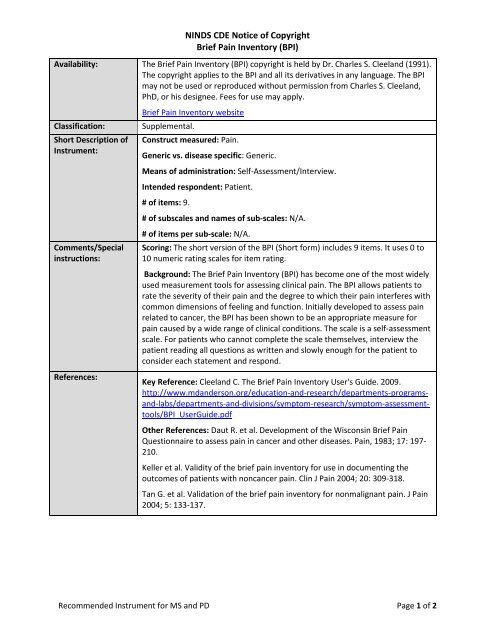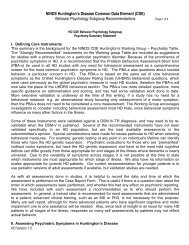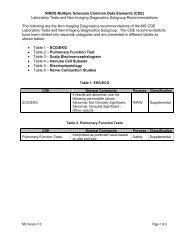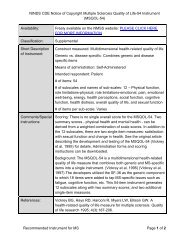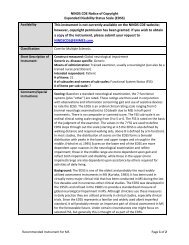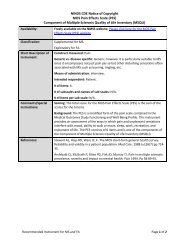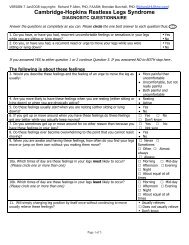Brief Pain Inventory - NINDS Common Data Elements
Brief Pain Inventory - NINDS Common Data Elements
Brief Pain Inventory - NINDS Common Data Elements
Create successful ePaper yourself
Turn your PDF publications into a flip-book with our unique Google optimized e-Paper software.
<strong>NINDS</strong> CDE Notice of Copyright<br />
<strong>Brief</strong> <strong>Pain</strong> <strong>Inventory</strong> (BPI)<br />
Availability: The <strong>Brief</strong> <strong>Pain</strong> <strong>Inventory</strong> (BPI) copyright is held by Dr. Charles S. Cleeland (1991).<br />
The copyright applies to the BPI and all its derivatives in any language. The BPI<br />
may not be used or reproduced without permission from Charles S. Cleeland,<br />
PhD, or his designee. Fees for use may apply.<br />
Classification:<br />
Short Description of<br />
Instrument:<br />
Comments/Special<br />
instructions:<br />
References:<br />
<strong>Brief</strong> <strong>Pain</strong> <strong>Inventory</strong> website<br />
Supplemental.<br />
Construct measured: <strong>Pain</strong>.<br />
Generic vs. disease specific: Generic.<br />
Means of administration: Self-Assessment/Interview.<br />
Intended respondent: Patient.<br />
# of items: 9.<br />
# of subscales and names of sub-scales: N/A.<br />
# of items per sub-scale: N/A.<br />
Scoring: The short version of the BPI (Short form) includes 9 items. It uses 0 to<br />
10 numeric rating scales for item rating.<br />
Background: The <strong>Brief</strong> <strong>Pain</strong> <strong>Inventory</strong> (BPI) has become one of the most widely<br />
used measurement tools for assessing clinical pain. The BPI allows patients to<br />
rate the severity of their pain and the degree to which their pain interferes with<br />
common dimensions of feeling and function. Initially developed to assess pain<br />
related to cancer, the BPI has been shown to be an appropriate measure for<br />
pain caused by a wide range of clinical conditions. The scale is a self-assessment<br />
scale. For patients who cannot complete the scale themselves, interview the<br />
patient reading all questions as written and slowly enough for the patient to<br />
consider each statement and respond.<br />
Key Reference: Cleeland C. The <strong>Brief</strong> <strong>Pain</strong> <strong>Inventory</strong> User's Guide. 2009.<br />
http://www.mdanderson.org/education-and-research/departments-programsand-labs/departments-and-divisions/symptom-research/symptom-assessmenttools/BPI_UserGuide.pdf<br />
Other References: Daut R. et al. Development of the Wisconsin <strong>Brief</strong> <strong>Pain</strong><br />
Questionnaire to assess pain in cancer and other diseases. <strong>Pain</strong>, 1983; 17: 197-<br />
210.<br />
Keller et al. Validity of the brief pain inventory for use in documenting the<br />
outcomes of patients with noncancer pain. Clin J <strong>Pain</strong> 2004; 20: 309-318.<br />
Tan G. et al. Validation of the brief pain inventory for nonmalignant pain. J <strong>Pain</strong><br />
2004; 5: 133-137.<br />
Recommended Instrument for MS and PD Page 1 of 2
<strong>NINDS</strong> CDE Notice of Copyright<br />
<strong>Brief</strong> <strong>Pain</strong> <strong>Inventory</strong> (BPI)<br />
Rationale/<br />
Justification:<br />
Strengths/ Weaknesses: The BPI has been used in hundreds of studies. In some<br />
ways, the BPI is a “legacy” instrument—a selfreport measure that has, over<br />
time, become a standard for the assessment of pain and its impact. It is<br />
recommended not to use the item BPIs item 9 a – g, dealing with pain’s<br />
interference with functions because the performance of this item may be<br />
confounded by other motor and nonmotor impairments.<br />
Psychometric Properties: The test-retest reliability of the BPI has been studied<br />
in cancer patients and other patients with pain. Initial short-term (1 day to 1<br />
week) reliability for ratings of pain “worst” (0.93) and “usual” or “average” pain<br />
(0.78) in patients with cancer was high, which signals acceptable reliability. As<br />
expected, test-retest reliability for pain “now” severity ratings were lower<br />
(0.59), In summary, the BPI is reliable to the extent that high test-retest<br />
reliability and alternate-form reliability is demonstrated when pain is stable or<br />
when pain changes in a predictable way.<br />
Administration: The scale is a self-assessment scale. For patients who cannot<br />
complete the scale themselves, interview the patient reading all questions as<br />
written and slowly enough for the patient to consider each statement and<br />
respond.<br />
Recommended Instrument for MS and PD Page 2 of 2


